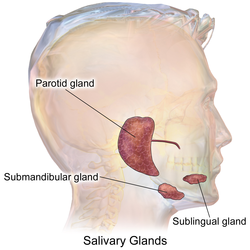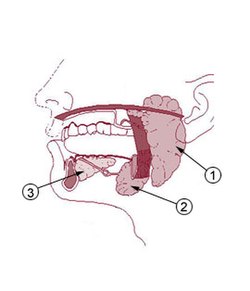Loading AI tools
Human salivary gland From Wikipedia, the free encyclopedia
The paired submandibular glands (historically known as submaxillary glands) are major salivary glands located beneath the floor of the mouth. In adult humans, they each weigh about 15 grams and contribute some 60–67% of unstimulated saliva secretion; on stimulation their contribution decreases in proportion as parotid gland secretion rises to 50%.[1] The average length of the normal adult human submandibular salivary gland is approximately 27 mm, while the average width is approximately 14.3 mm.[2]
| Submandibular gland | |
|---|---|
 | |
 | |
| Details | |
| Artery | Glandular branches of facial artery |
| Nerve | Submandibular ganglion |
| Identifiers | |
| Latin | glandula submandibularis |
| MeSH | D013363 |
| TA98 | A05.1.02.011 |
| TA2 | 2810 |
| FMA | 55093 |
| Anatomical terminology | |

Each submandibular gland is divided into a superficial lobe and a deep lobe, the two being separated by the mylohyoid muscle:[3]
Secretions are delivered into the submandibular duct on the deep portion after which they hook around the posterior edge of the mylohyoid muscle and proceed on the superior surface laterally. The excretory ducts are then crossed by the lingual nerve, and ultimately drain into the sublingual caruncles – small prominences on either side of the lingual frenulum along with the major sublingual duct. The gland can be bilaterally palpated (felt) inferior and posterior to the body of the mandible, moving inward from the inferior border of the mandible near its angle with the head tilted forwards.[4]
The terminal part of the submandibular (Wharton's) duct is located in the mouth floor and opens as an orifice of the submandibular duct papilla. The position of the duct and its 0.5–1.5 mm wide ostium is invariably symmetric, but quite unpredictable; consequently, submandibular duct papillae can occasionally be challenging to recognize. Based on the macroscopic appearance of the papillae and a sialoendoscopic approach, Anicin et al. described four different types of submandibular gland papillae: types A, B, C, and D.[5]

Lobes contain smaller lobules, which contain adenomeres, the secretory units of the gland. Each adenomere contains one or more acini, or alveoli, which are small clusters of cells that secrete their products into a duct. The acini of each adenomere are composed of either serous or mucous cells, with serous adenomeres predominating.[6] Some mucous adenomeres may also be capped with a serous demilune, a layer of lysozyme-secreting serous cells resembling a half moon.
Like other exocrine glands, the submandibular gland can be classified by the microscopic anatomy of its secretory cells and how they are arranged. Because the glands are branched, and because the tubules forming the branches contain secretory cells, submandibular glands are classified as branched tubuloacinar glands. Further, because the secretory cells are of both serous and mucous types, the submandibular gland is a mixed gland, and though most of the cells are serous, the exudate is chiefly mucous. It has long striated ducts and short intercalated ducts.[7]
The secretory acinar cells of the submandibular gland have distinct functions. The mucous cells are the most active and therefore the major product of the submandibular glands is saliva which is mucoid in nature. Mucous cells secrete mucin which aids in the lubrication of the food bolus as it travels through the esophagus. In addition, the serous cells produce salivary amylase, which aids in the breakdown of starches in the mouth. The submandibular gland's highly active acini account for most of the salivary volume. The parotid and sublingual glands account for the remaining.
The gland receives its blood supply from the facial and lingual arteries.[8] The gland is supplied by sublingual and submental arteries and drained by common facial and lingual veins.
The lymphatics from submandibular gland first drain into submandibular lymph nodes and subsequently into jugulo - digastric lymph nodes.

Their secretions, like the secretions of other salivary glands, are regulated directly by the parasympathetic nervous system and indirectly by the sympathetic nervous system.
The submandibular gland occurs within the submandibular triangle. It is situated posteroinferior to the ramus of mandible,[12]: 601 and between the two bellies of the digastric muscle.[12]: 601
The submandibular salivary glands develop later than the parotid glands and appear late in the sixth week of prenatal development. They develop bilaterally from epithelial buds in the sulcus surrounding the sublingual folds on the floor of the primitive mouth. Solid cords branch from the buds and grow posteriorly, lateral to the developing tongue. The cords of the submandibular gland later branch further and then become canalized to form the ductal part. The submandibular gland acini develop from the cords’ rounded terminal ends at 12 weeks, and secretory activity via the submandibular duct begins at 16 weeks. Growth of the submandibular gland continues after birth with the formation of more acini. Lateral to both sides of the tongue, a linear groove develops and closes over to form the submandibular duct.[7]
The submandibular gland is one of the major three glands that provide the mouth with saliva. The two other types of salivary glands are parotid and sublingual glands.[13]
The submandibular gland releases a host of factors which regulate systemic inflammatory responses and modulate systemic immune and inflammatory reactions. Early work in identifying factors that played a role in the cervical sympathetic trunk-submandibular gland (CST-SMG) axis lead to the discovery of a seven amino acid peptide, called the submandibular gland peptide-T. SGP-T was demonstrated to have biological activity and thermoregulatory properties related to endotoxin exposure.[14] SGP-T, an isolate of the submandibular gland, demonstrated its immunoregulatory properties and potential role in modulating the CST-SMG axis, and subsequently was shown to play an important role in the control of inflammation.

The submandibular gland accounts for 80% of all salivary duct calculi (salivary stones or sialolith), possibly due to the different nature of the saliva that it produces and the tortuous travel of the submandibular duct to its ductal opening for a considerable upward distance.[16]
Benign and malignant tumors can also develop in the submandibular gland (see pie chart).
Seamless Wikipedia browsing. On steroids.
Every time you click a link to Wikipedia, Wiktionary or Wikiquote in your browser's search results, it will show the modern Wikiwand interface.
Wikiwand extension is a five stars, simple, with minimum permission required to keep your browsing private, safe and transparent.